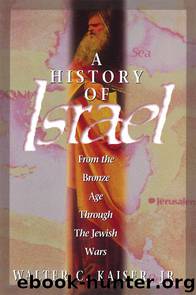A History of Israel by Walter C. Kaiser Jr

Author:Walter C. Kaiser Jr. [Kaiser Jr., Walter C.]
Language: eng
Format: mobi
Publisher: B&H Publishing
Published: 2010-09-30T16:00:00+00:00
From Holman Bible Handbook (Nashville: Holman Bible Publishers, 1992), 259.
_________________________
1. Albrecht Alt, “The Formation of the Israelite State in Palestine,” in Essays on Old Testament History and Religion, tr. R. A. Wilson (Garden City, N.Y.: Doubleday, 1968), 282-83.
2. See Kathleen M. Kenyon, The Bible and Recent Archaeology, rev. ed. (Atlanta: John Knox, 1987), 92; also Philip J. King's review of Harry Thomas Frank, Discovering the Biblical World, ed. James F. Strange; rev. ed., (Maplewood: Hammond, 1988) in BAR 15 (1989): 13.
3. See Dan Bahat and Chaim T. Rubinstein, The Illustrated Atlas of Jerusalem, tr. Shlomo Ketko (New York: Simon and Schuster, 1990), 16, 24. Also see N. Avigad, Discovering Jerusalem (New York, 1983) and Y. Shiloh, Excavations at the City of David. QEDEM 19 (Jerusalem: 1984).
4. W. Harold Mare, The Archaeology of the Jerusalem Area (Grand Rapids: Baker, 1987), p. 65; also Kathleen Kenyon, Royal Cities of the Old Testament (New York: Schocken, 1971), pp. 33-35.
5. Usually the date given for the destruction of Shiloh is 1050 B.C. (e.g., John Bright, A History of Israel, 3rd ed. (Philadelphia: Westminster, 1981), 185-86. But Eugene H. Merrill, Kingdom of Priests, p. 176, notes that the Bible does not say that Shiloh was destroyed at the same time that the ark was lost to the Philistines. He argues that the destruction referred to in Jeremiah 7:12, 14; 26:6, 9 may have taken place as much as fifty years after the tabernacle had long been removed from that city to Nob and Gibeon. It is difficult to say, for the evidence is not clear one way or the other.
6. See the definitive article by Asher S. Kaufman, “Fixing the Site of the Tabernacle at Shiloh,” BAR 14.6 (1988): 46-52. This identification some will find tentative at best, with some justification. On Ebenezer, see Moshekochav and Aaron Demsky, ‘An Israelite Village from the Days of the Judges,” BAR 4 (1978): 18-21.
7. This section is indebted to the careful suggestions made by Eugene H. Merrill, Kingdom of Priests, pp. 243-48.
8. Eugene H. Merrill, Kingdom of Priests, p. 248, n. 37, calls attention to the fact that “if one fails to recognize a time interval between 1 Chronicles 29:22 a and b … [one must] see H. G. M. Williams, I and II Chronicles, New Century Bible Commentary (Grand Rapids: Eerdmans, 1982), 186-87” for the problems thus incurred.
9. See Kenneth A. Kitchen, The Third Intermediate Period in Egypt (1100-650 B.C.) (Warminster: Aris and Phillips, 1973) and Pierre Montet, Egypt and the Bible (Philadelphia: Fortress, 1968), 38-39.
10. This spelling of the pharaoh's name is found in Sir Alan Gardiner, Egypt of the Pharaohs: An Introduction (Oxford: At the Clarendon Press, 1961), 318, 447.
11. The only major study on the Ammonites in English is George M. Landes, A History of the Ammonites (Ph.D. dissertation, Johns Hopkins University, 1956). More recently, Randall W. Younker, “Ammonites,” in Peoples of the Old Testament, ed. Alfred J. Hoerth, Gerald L. Mattingly, and Edwin M. Yamauchi (Grand Rapids: Baker, 1994), 293-316; Daniel I. Block, “Bny ‘mum: The Sons of Ammon,” AUSS 22 (1984): 197-212; Larry G.
Download
This site does not store any files on its server. We only index and link to content provided by other sites. Please contact the content providers to delete copyright contents if any and email us, we'll remove relevant links or contents immediately.
Unearthing the Bible by Titus M Kennedy(662)
Moses Among the Idols by Amy L. Balogh(466)
Digging Up Armageddon by Eric H. Cline(464)
NKJV, Cultural Backgrounds Study Bible by Craig S. Keener(441)
A Concise History of Ancient Israel (Critical Studies in the Hebrew Bible) by Bernd U. Schipper(423)
How the Gospels Became History by M. David Litwa;(396)
The New Testament in Its World by N. T. Wright & Michael F. Bird(394)
The Cultural World of the Bible by Matthews Victor H(364)
The Spiritual World of Ancient China and the Bible by Brian Godawa(362)
Shepherds After My Own Heart by Timothy Laniak(361)
The Spiritual World of Jezebel and Elijah by Brian Godawa(351)
Old Testament Theology for Christians by John H. Walton(320)
Idols of Nations by Roland Boer(304)
A Biblical History of Israel by Iain Provan & V. Philips Long & Tremper Longman III(302)
A History of Israel by Walter C. Kaiser Jr. & Paul D. Wegner(297)
Old Testament Theology for Christians by Walton John H.;(297)
A History of Israel by Walter C. Kaiser Jr(273)
Long Before Luther: Tracing the Heart of the Gospel From Christ to the Reformation by Nathan Busenitz(273)
Chosen?: Reading the Bible Amid the Israeli-Palestinian Conflict by Walter Brueggemann(253)
